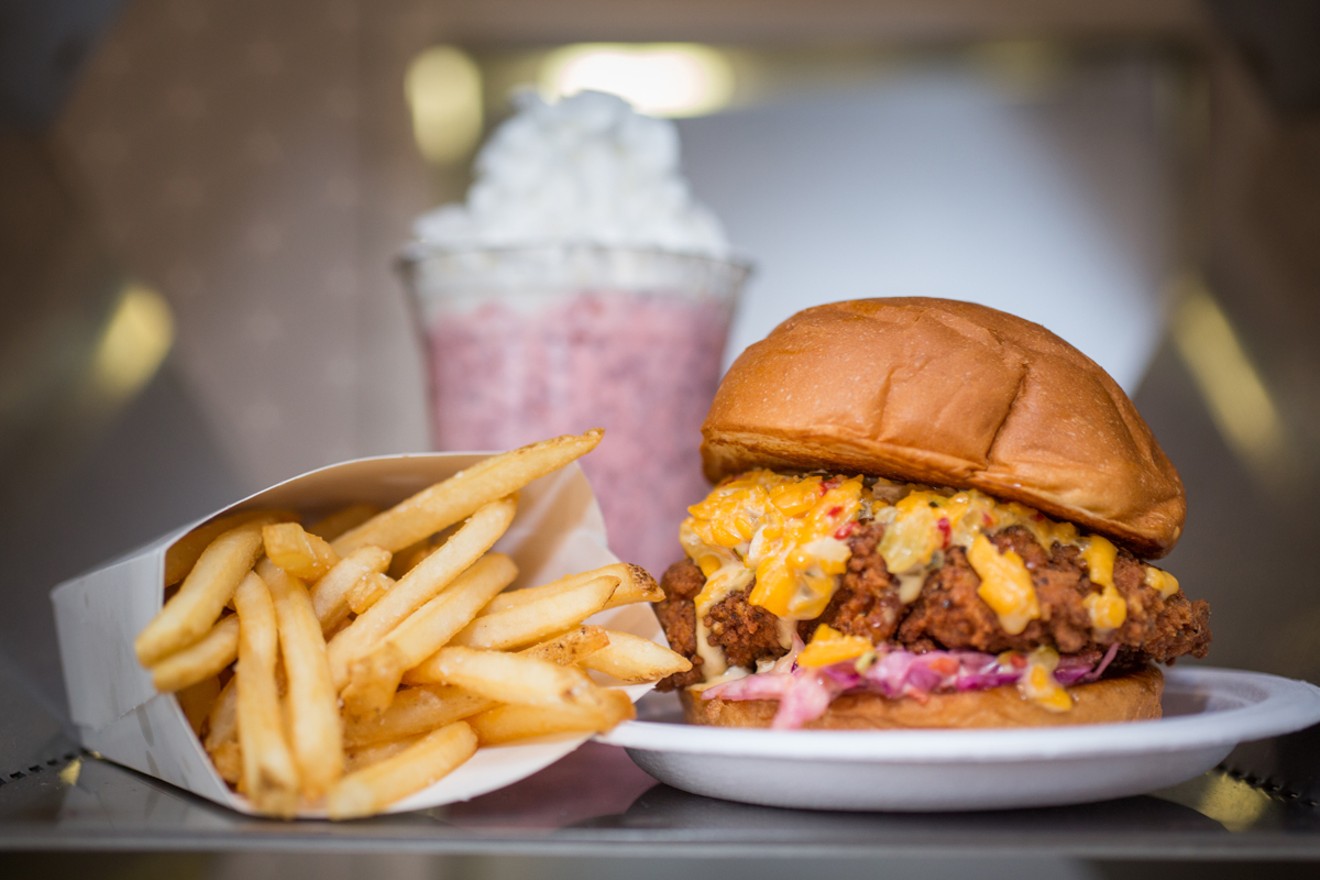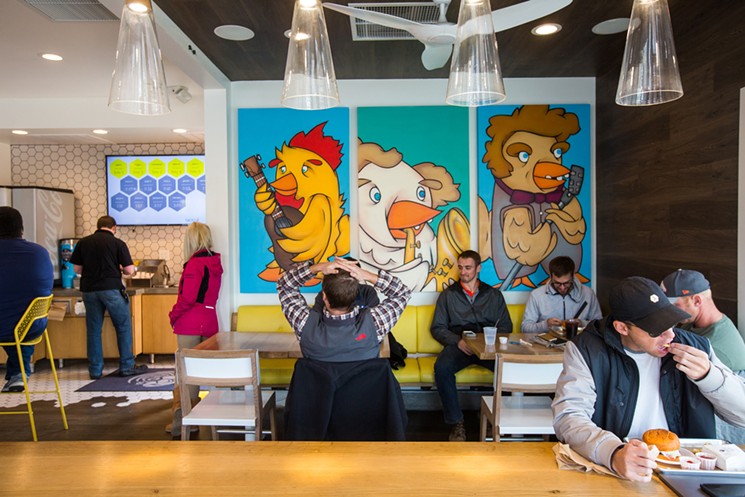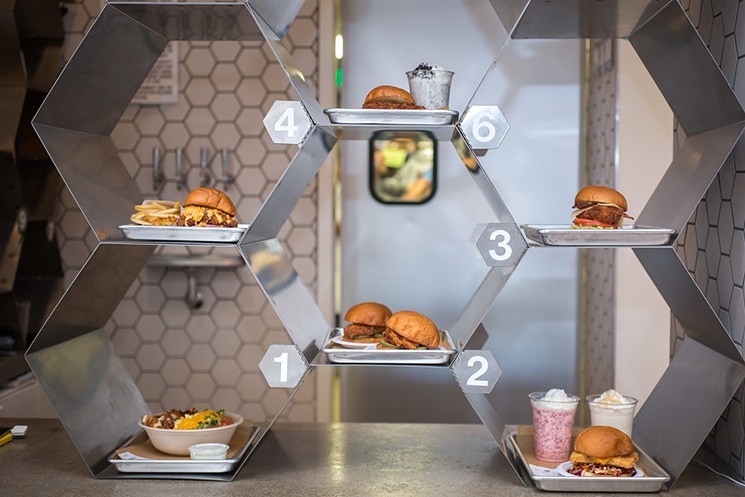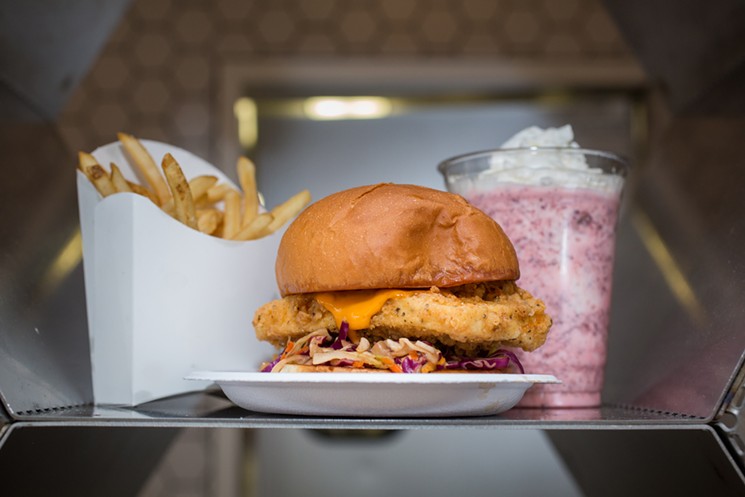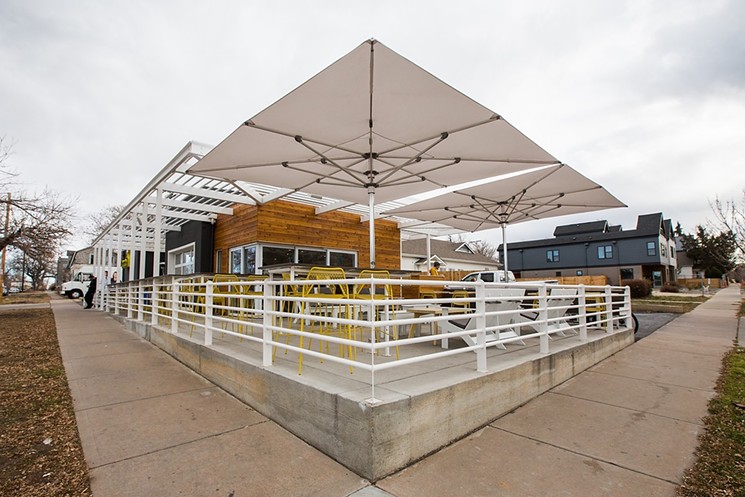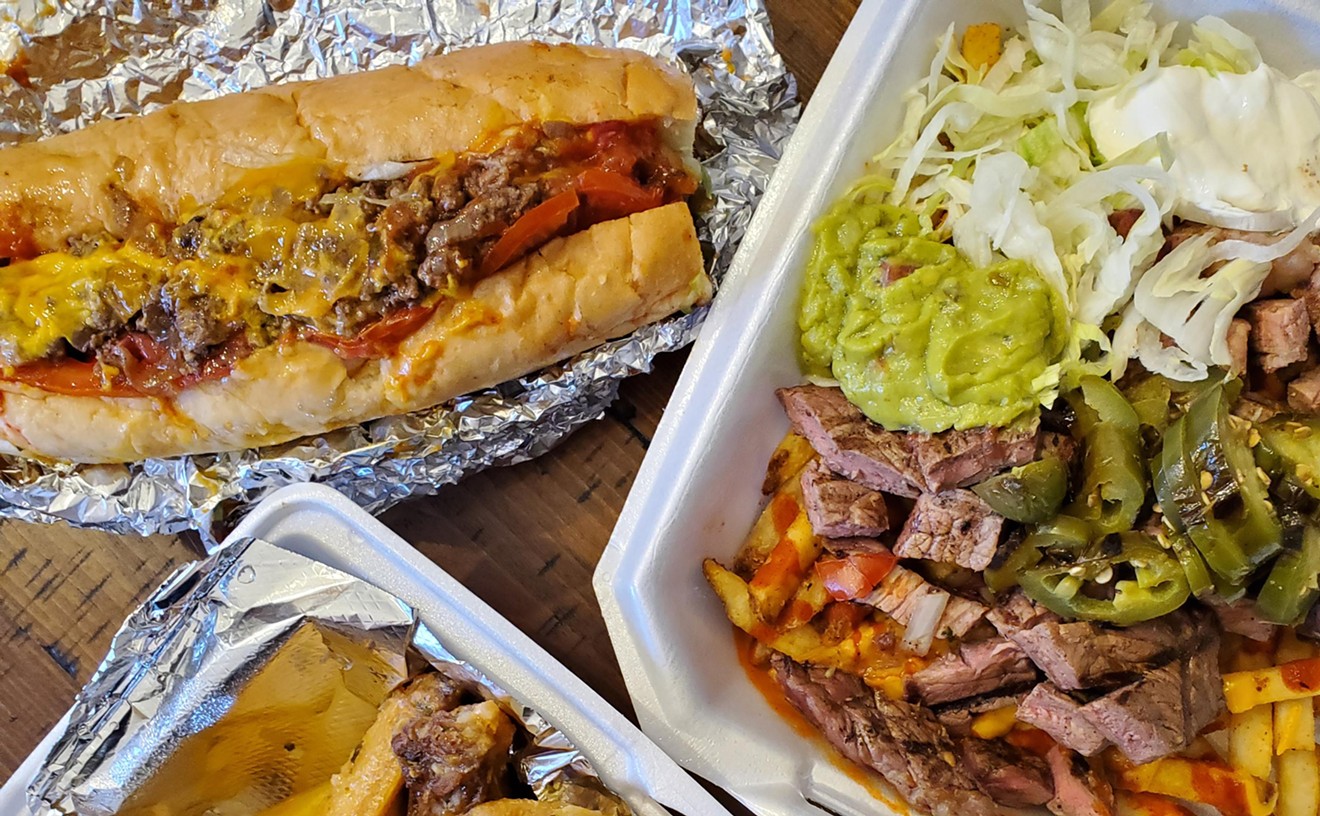If I were a technology reporter or food blogger who’d been treated to a press lunch, with everything cooked and plated as if it were headed for a photo shoot, I’d be writing a different piece right now about Birdcall. (I’d also be making the name all lowercase, as the owners request.) Because the official story of Birdcall, a high-tech pioneer in the restaurant industry, is a page-turner. Who wouldn’t be captivated by how the owners of this fast-food chicken joint — the same crew behind Park Burger and Homegrown Tap & Dough — solved the dilemma of turning a profit in the food industry by replacing humans with bright-yellow ordering kiosks?
With a few taps on a touch screen to answer on-screen prompts — “Make this a combo?” — you breeze through the roster of sandwiches, salads, fries and shakes, adding sauces or other extras to get your food just the way you want it. Then you pay with a swipe and step aside, keeping an eye on the countdown clock with your name on it until your food is delivered to a shiny, beehive-like bin. Cool, huh? If you’re a tech junkie, your brain is probably on fire right now. If you’re a closet fan of fast food and ready to come out of hiding, you’re surely reading this on your device as you race to the car, since antibiotic-free chicken and scratch salad dressings take away some of the stigma. And forget those holiday visions of sugarplums: Food-industry folks will surely sleep sweeter tonight, dreaming of savings from no cashiers or servers to hire, train and compensate. Besides an expediter, who delivers paper sacks in about six minutes to the pick-up station, the only front-of-house employee is a “bird tender” (Birdcall’s term, not mine) whose role is to process cash orders and provide hospitality (again, Birdcall’s term, not mine, since hospitality seems almost oxymoronic in an automated fast-food joint).
Since this is a nascent industry, with San Francisco’s Eatsa the best-known restaurant in this soon-to-explode niche, Birdcall co-owner Peter Newlin lived out his own Hansel and Gretel narrative, traveling the country to try out point-of-sale systems, taking notes on what worked and what didn’t (like why it was so hard to remove an item once it was in his cart), and vowing to design a system intuitive enough for his mom to use. Along the way, he dropped breadcrumbs for the hordes of cost-sensitive restaurateurs who will no doubt follow, hot on the trail of his cutting-edge POS system designed with the user in mind. How hot? The owners already report strong interest in franchise opportunities, despite the fact that they only have two kitchens: the original, which took over the former address of the beloved Tom’s Home Cookin’ in Five Points, and now sits like a sleek glass cube you’d find in Dwell magazine, with yellow stools and garage doors that open onto patios; and a second in Whole Foods-Union Station, which feels friendlier than the first given its twelve actual seats at the bar, 25 draft beers and views into the kitchen. A third is in the works near the University of Denver.
The story gets better, because Newlin worked on the ordering system with a local software designer. Colorful artwork was painted by local talent. Those yellow stools, custom-built by a local furniture designer, were spotlighted at a prestigious design show in Milan. Good things all. But you don’t eat software or chairs. When that tech reporter or food blogger finishes his piece, I want to know this: How’s the food? How’s the vibe? Is Birdcall worth my time and money?
Here’s the thing about that trail-blazing design: When you take servers, hosts and cashiers out of the equation, you’re left with a restaurant that feels lonely, even eerie. I went away with a WALL-E vision of the future, and was glad not to live there (yet). Several nights, I was the only person in the front of the house at the Five Points shop; the cooks were no doubt somewhere, but I couldn’t hear them, and the expediter and bird tender weren’t around. The kiosks seemed too sterile, the lighting and music — strains of “Qué será será, whatever will be, will be” — overly peppy and bright. A guy walked in, did a double take and paused. “Is it open?” he asked me. Even when the restaurant is full, it’s still impersonal, people head-down, consumed by their smartphones, killing time until they grab their bags and go. “I wouldn’t want to work here,” said a girl at the community counter near us one night. “It seems so lonely.”
Fried chicken should be the headline, but it’s not worthy of top billing. Nearly every chicken patty I ate at the original location — the focus of this review since it’s been open five months, rather than one at Union Station — had a thin, almost smooth coating that added more color than crunch. I thought the cooking method was to blame, since the patties are dredged and fried once, not twice, as they could be for extra-crispiness. Then one morning, for curiosity’s sake, I picked up a Southern chicken-and-egg sandwich from the Birdcall in Whole Foods, on the edge of the store’s prepared-foods section, past the candy bar and a case of flaky croissants. This bird was deep gold, several shades darker than what I’d seen in Five Points, with swirls and ridges that crackled the way fried things should.
How to account for the difference? Was this chicken pulled fresh from the pressure fryer, and the others cooked and held? Was there a variation in the recipe? That’s unlikely, but the milkshakes are made differently depending on location, with higher-quality hard-serve from locally owned Liks at Whole Foods, and runnier, sweeter soft-serve in Five Points that gets gritty from over-pulverized cookie crumbs. Or was that one remarkable breakfast sandwich — picture-perfect, with pimento cheese that melted on contact with the generous portion of hot, crispy bird, a baked egg and long strips of bacon that crisscrossed and draped well off the bun — simply better because the chicken had been left longer in the fryer? Who knows?
What I do know is that twenty minutes later, as I sat in the parking lot at the original Birdcall and pulled another Southern chicken-and-egg sandwich from a shiny foil bag, I got an entirely different beast, with shorter strips of bacon, a half-hearted smear of pimento cheese and a soggy breast. My first few bites were all bun, and when I lifted the lid, I saw why: The breast had been cut in half, to the size of something you’d plop on a happy-hour slider. Such inconsistency points to execution problems that are anathema to fast food, where consistency is critical for long-term success.
Other fare at the original Birdcall was much better. A grilled Caesar chicken sandwich had a thick layer of dressing-tossed lettuce, plus a pancake-sized Parmesan crisp that spoke to co-owner Jean-Philippe Failyau’s background as a trained chef. Failyau also did wonders designing the chicken-satay sandwich, with a bold punch of peanut butter, fish sauce and Thai chile paste, and the veggie, which proved to be the surprise hit, with crispy tofu, peanut slaw and spicy aioli. Asian and power salads were also winners, with a produce section’s worth of vegetables, and greens that started out as heads of romaine, not leafy bits in a plastic bag. Fries were skinny, evenly salted and insanely crisp, as good as the ones at McDonald’s — and that’s saying something, since McDonald’s makes the fries that shaped our national palate.
But other sandwiches did less to distinguish themselves from the realm of fast food. The original lacked flavor, since it’s little more than chicken and pickles, and the coating on the chicken needed a few more shakes of seasoning. The bun didn’t add much; it was seedless and minus that sweet bakery aroma that makes people fall for Chick-fil-A. The Nashville Hot is a bestseller, but mine dripped reddish oil that didn’t pack much heat. Slaw on the Southern chicken was crispy but dull, and pimento-cheese spread cried out for sharper Cheddar and more pimentos.
So what’s the real story of Birdcall, the one that matters not to a tech writer or food blogger who got a free meal but to people like you and me, who view this spot as one more option in a city already full of them? Birdcall is fast. It’s affordable. It feels far friendlier when sited in a bustling grocery store. And it’s where the future is headed, given the pinch of high labor costs. But at some point the technology will become a commodity, and when that day comes, the model will require tweaks in food consistency and the role of the bird tenders. If Birdcall can successfully meet that challenge, it has the potential to redefine the fast-food category.
And that would be a real headline.
Birdcall
800 East 26th Avenue
720-361-2976
eatbirdcall.com
Hours: 7 a.m. to 10 p.m. Monday through Friday, 8 a.m. to 10 p.m. Saturday and Sunday
Select menu items:
Southern chicken and egg $5.75
The original $5.75
Nashville hot $5.75
Southern chicken $7.50
Chicken satay $6.95
Grilled Caesar chicken sandwich $6.75
The veggie $7.25
Shakes $4.75
[
{
"name": "Air - MediumRectangle - Inline Content - Mobile Display Size",
"component": "12017618",
"insertPoint": "2",
"requiredCountToDisplay": "2"
},{
"name": "Editor Picks",
"component": "17242653",
"insertPoint": "4",
"requiredCountToDisplay": "1"
},{
"name": "Inline Links",
"component": "18838239",
"insertPoint": "8th",
"startingPoint": 8,
"requiredCountToDisplay": "7",
"maxInsertions": 25
},{
"name": "Air - MediumRectangle - Combo - Inline Content",
"component": "17261320",
"insertPoint": "8th",
"startingPoint": 8,
"requiredCountToDisplay": "7",
"maxInsertions": 25
},{
"name": "Inline Links",
"component": "18838239",
"insertPoint": "8th",
"startingPoint": 12,
"requiredCountToDisplay": "11",
"maxInsertions": 25
},{
"name": "Air - Leaderboard Tower - Combo - Inline Content",
"component": "17261321",
"insertPoint": "8th",
"startingPoint": 12,
"requiredCountToDisplay": "11",
"maxInsertions": 25
}
]

